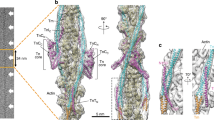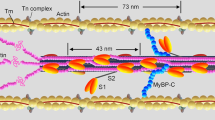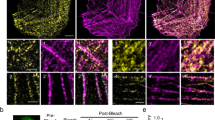Abstract
CALCIUM regulates muscle contraction in all species which have been studied. Muscle relaxes in the absence of calcium and contracts when it is present in micromolar concentrations1–3. Contraction is caused by the interaction of myosin with ATP and with the actin of the thin filament, and the effect of calcium is to modulate this interaction1–8. Although these features apply to all muscles, the location of the calcium binding and thus the mechanism of its action differs in different phyla; regulation may be associated with the myosin, or the thin filaments or both2,3,7.
This is a preview of subscription content, access via your institution
Access options
Subscribe to this journal
Receive 51 print issues and online access
$199.00 per year
only $3.90 per issue
Buy this article
- Purchase on Springer Link
- Instant access to full article PDF
Prices may be subject to local taxes which are calculated during checkout
Similar content being viewed by others
References
Ebashi, S., and Endo, M., Prog. Biophys Molec. Biol., 18, 123–183 (1968).
Murray, J. M., and Weber, A., Physiol. Rev., 53, 672–673 (1973).
Lehman, W., Kendrick-Jones, J., and Szent-Györgyi, A. G., Cold Spring Harbor Symp. quant. Biol., 37, 319–330 (1973).
Eisenberg, E., and Kielley, W. W., Biochem. Biophys. Res. Commun., 40, 50–56 (1970).
Parker, L., Pyun, H. Y., and Hartshorne, D. J., Biochim. biophys. Acta, 223, 453–456 (1970).
Koretz, J., Hunt, T., and Taylor, E. W., Cold Spring. Harbor Symp. quant. Biol., 37, 179–184 (1973).
Kendrick-Jones, J., Lehman, W., and Szent-Györgyi, A. G., J. molec. Biol., 54, 313–326 (1970).
Szent-Györgyi, A. G., Szentkiralvi, E. M., and Kendrick-Jones, J., J. molec. Biol., 74, 179–203 (1973).
Lymm, R., and Taylor, E. W., Biochemistry, 9, 2975–2983 (1970).
Taylor, E. W., Lymn, R., and Moll, G., Biochemistry, 9, 2984 (1970).
Lymn, R., and Taylor, E. W., Biochemistry, 10, 4617–4624 (1971).
Marston, S. B., Biochim. biophys. Acta, 305, 397–412 (1973).
Marston, S. B., and Tregear, R., Biochim. biophys. Acta, 333, 581–584 (1974).
Wilkinson, G. N., Biochem. J., 80, 324–332 (1961).
Godfrey, J. E., and Harrington, W. F., Biochemistry, 9, 886–893 (1970).
Lowey, S., Slater, H., Weeds, A., and Baker, H., J. molec. Biol., 42, 1–29 (1969).
Lehman, W., Bullard, B., and Hammond, K., J. gen. Physiol., 63, 553–563 (1974).
Author information
Authors and Affiliations
Rights and permissions
About this article
Cite this article
MARSTON, S., LEHMAN, W. ADP binding to relaxed scallop myofibrils. Nature 252, 38–39 (1974). https://doi.org/10.1038/252038a0
Received:
Issue Date:
DOI: https://doi.org/10.1038/252038a0
This article is cited by
Comments
By submitting a comment you agree to abide by our Terms and Community Guidelines. If you find something abusive or that does not comply with our terms or guidelines please flag it as inappropriate.



